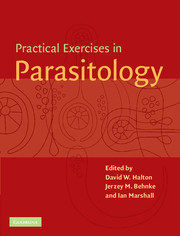Book contents
- Frontmatter
- Contents
- List of contributors
- Preface
- General advice
- 1 Observational Exercises on Parasites
- A Local wild and domestic hosts as sources of parasites
- B Laboratory maintained species
- 1.8 Protozoan parasites of the intestinal tract of the cockroach, Periplaneta americana
- 1.9 Protozoan parasites of the mouse intestinal tract
- 1.10 Rodent malaria
- 1.11 Malaria: an example of a vector transmitted parasite
- 1.12 Larval and adult Echinostoma spp. (Trematoda)
- 1.13 Schistosoma mansoni (Trematoda)
- 1.14 Hymenolepis diminuta (Cestoda)
- 1.15 Heligmosomoides polygyrus (Nematoda)
- 2 Ecology
- 3 Physiology and Biochemistry
- 4 Pathology and Immunology
- 5 Chemotherapy
- 6 Molecular Parasitology
- 7 Behaviour
- Appendix 1 Reagent index
- Appendix 2 UK suppliers
- Appendix 3 US suppliers
- Index
1.13 - Schistosoma mansoni (Trematoda)
Published online by Cambridge University Press: 05 June 2012
- Frontmatter
- Contents
- List of contributors
- Preface
- General advice
- 1 Observational Exercises on Parasites
- A Local wild and domestic hosts as sources of parasites
- B Laboratory maintained species
- 1.8 Protozoan parasites of the intestinal tract of the cockroach, Periplaneta americana
- 1.9 Protozoan parasites of the mouse intestinal tract
- 1.10 Rodent malaria
- 1.11 Malaria: an example of a vector transmitted parasite
- 1.12 Larval and adult Echinostoma spp. (Trematoda)
- 1.13 Schistosoma mansoni (Trematoda)
- 1.14 Hymenolepis diminuta (Cestoda)
- 1.15 Heligmosomoides polygyrus (Nematoda)
- 2 Ecology
- 3 Physiology and Biochemistry
- 4 Pathology and Immunology
- 5 Chemotherapy
- 6 Molecular Parasitology
- 7 Behaviour
- Appendix 1 Reagent index
- Appendix 2 UK suppliers
- Appendix 3 US suppliers
- Index
Summary
Aims and objectives
This exercise is designed to demonstrate:
The external and internal morphology of the adult schistosome.
The pairing behaviour of the adult worms.
Destination of eggs.
Hatching of miracidia from eggs.
Some gross effects of infection on the mouse host.
Introduction
Schistosomiasis is one of the most important public health problems in the tropics. Despite intensive research, there is still no easy cure for the disease and no simple way to control transmission. It is estimated that some 200 million people are infected with schistosomes.
The human schistosomes and many of the other species in mammals belong to the genus Schistosoma, in the family Schistosomatidae. Members of this family show morphological and physiological peculiarities that set them apart from all the other trematodes. Firstly, they are dioecious, the male carrying the female in a ventral canal, the gynaecophoric canal, and secondly, they live in the bloodstream of warm-blooded hosts (See Fig. 1.13.1 for details of the life cycle).
Five species of blood flukes may infect humans, causing schistosomiasis or Bilharzia. Three of these species are very common. S. mansoni is found in Africa and South America and affects chiefly the large intestine in humans; S. haematobium is found in Africa and the Middle East and affects the urino-genital system; S. japonicum is found in parts of Asia and affects mainly the large intestine.
- Type
- Chapter
- Information
- Practical Exercises in Parasitology , pp. 107 - 114Publisher: Cambridge University PressPrint publication year: 2001



